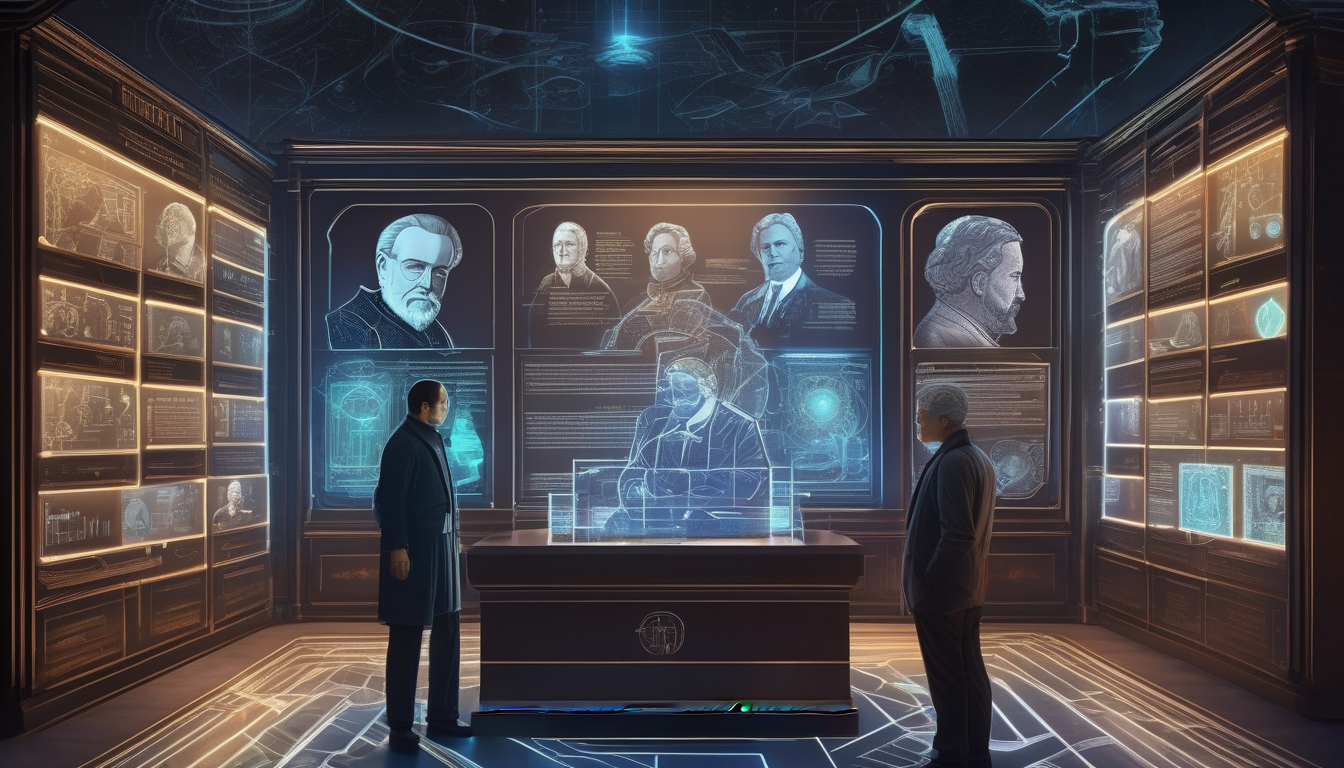Imagine stepping into the shoes of a historical figure, feeling their thoughts and emotions as if they were your own. Artificial intelligence is transforming this dream into reality, allowing us to explore the minds of the past like never before. With AI, we can delve into the intricacies of historical figures, understanding not just what they did, but why they did it. This innovative approach blends technology with history, offering a unique perspective that enriches our comprehension of societal impacts.
AI’s ability to process massive amounts of data enables researchers to identify patterns and connections that were previously hidden. By analyzing letters, diaries, and historical documents, AI can help us piece together the complex tapestry of human experience. For instance, consider how AI can analyze the writings of Leonardo da Vinci or Marie Curie. It can reveal their motivations, fears, and aspirations, providing a more nuanced understanding of their contributions to society.
In essence, AI serves as a modern-day time machine, transporting us back to pivotal moments in history. Through simulations and data analysis, we can engage with the ideas of figures like Nelson Mandela or Cleopatra, experiencing their thoughts in a contemporary context. This interaction not only makes history more relatable but also ignites a passion for learning among younger generations.
As we embark on this journey of discovery, it’s essential to recognize the ethical implications of using AI in historical research. Accuracy and representation are paramount, as misinterpretations can lead to distorted perceptions of the past. Thus, while AI opens new doors to understanding history, it also challenges us to approach these technologies responsibly.
Ultimately, the fusion of AI and historical inquiry promises to reshape our understanding of the past, allowing us to visualize and appreciate the minds that have shaped our world. So, are you ready to explore history through the lens of AI?

The Role of AI in Historical Research
Artificial Intelligence is not just a buzzword; it’s a game-changer in the realm of historical research. Imagine having the ability to sift through mountains of historical data in mere seconds! AI technologies are revolutionizing how historians and researchers analyze past events, making it easier to identify patterns that might have gone unnoticed for centuries. This is akin to having a super-sleuth at your disposal, capable of connecting the dots between seemingly unrelated events.
One of the most exciting aspects of AI in historical research is its data analysis capabilities. By utilizing machine learning algorithms, researchers can uncover insights from vast datasets, revealing hidden trends and correlations. For instance, AI can analyze letters, diaries, and official documents to highlight how social, economic, and political factors influenced historical figures. This not only enhances our understanding of individual lives but also contextualizes their actions within a broader framework.
Moreover, AI can assist in digitizing and preserving historical artifacts. By creating digital records, it ensures that valuable information is not lost to time. These digital archives can be made accessible to researchers and the public alike, democratizing historical knowledge. Imagine being able to explore ancient manuscripts or artifacts from the comfort of your home!
However, it’s essential to approach this technology with a critical eye. While AI offers incredible tools for historical analysis, it also raises questions about accuracy and bias. As researchers, we must remain vigilant to ensure that the insights generated by AI are reliable and representative of diverse perspectives. After all, history is not just about dates and events; it’s about the stories and experiences of people.
In summary, the role of AI in historical research is transformative. It opens up new avenues for exploration and understanding, allowing us to engage with the past in ways we never thought possible. As we continue to harness this technology, the future of historical research looks brighter than ever!

Recreating Historical Figures with AI
Imagine stepping into a world where you can have a conversation with Albert Einstein or debate with Cleopatra. Sounds like something out of a sci-fi movie, right? Well, thanks to advancements in artificial intelligence, this dream is becoming a reality. Through machine learning and natural language processing, AI can simulate the thoughts and behaviors of historical figures, allowing us to engage with their ideas in a modern context.
These technologies enable historians and educators to create realistic digital avatars that embody the essence of these iconic figures. Imagine an interactive classroom where students can ask questions and receive answers in the voice of Leonardo da Vinci or Marie Curie. This immersive experience not only makes learning more engaging but also helps students grasp complex historical concepts more effectively.
Moreover, the potential applications of AI in this realm are vast. For instance, in the field of education, institutions are increasingly adopting AI-generated avatars to enhance history lessons. This approach fosters a deeper understanding of historical contexts by allowing students to:
- Interact with avatars that provide insights into their lives and decisions.
- Explore different historical perspectives through simulated dialogues.
- Engage in role-playing scenarios that bring history to life.
On the entertainment front, films and video games are also leveraging AI to portray historical characters with greater accuracy. This not only enhances storytelling but also provides audiences with a richer experience of history. Imagine watching a film where the main character is a lifelike representation of a historical figure, complete with their mannerisms and thought processes!
However, while the ability to recreate historical figures with AI opens up exciting possibilities, it also raises questions about authenticity and representation. How do we ensure that these digital recreations are accurate and respectful? These are crucial discussions that need to take place as we navigate this fascinating intersection of technology and history.
Digital Avatars of Historical Figures
Imagine stepping into a world where you can have a conversation with Abraham Lincoln or share ideas with Marie Curie. Thanks to advancements in artificial intelligence, this is becoming a reality through the creation of digital avatars of historical figures. These lifelike representations are not just static images; they embody the essence of these iconic individuals, allowing us to interact with them in ways that were once the stuff of science fiction.
These digital avatars are crafted using sophisticated technologies like machine learning and natural language processing. By analyzing historical texts, speeches, and other data, AI can simulate the thoughts and behaviors of these figures, creating a more authentic experience. It’s like having a time machine at your fingertips, where you can explore the minds of those who shaped our world. Imagine asking Leonardo da Vinci about his artistic process or seeking advice from Nelson Mandela on leadership!
One of the most exciting applications of these avatars is in the field of education. Schools and universities are harnessing this technology to make history lessons more engaging. Instead of reading about historical events, students can interact with avatars, asking questions and receiving responses that reflect the historical context and personality of the figures. This immersive learning experience can foster a deeper understanding of the past, making history feel less like a series of dates and more like a vibrant narrative.
In addition to education, the entertainment industry is also benefiting from these digital avatars. Films and video games are increasingly using AI to portray historical characters with remarkable accuracy. This not only enhances storytelling but also provides audiences with a richer, more nuanced experience of history. Imagine watching a film where the characters are not just actors but living representations of the historical figures they portray, complete with their unique quirks and perspectives.
As we continue to explore the potential of digital avatars, the possibilities are endless. They offer a unique way to connect with the past, bridging the gap between history and modern technology. However, as we delve into this exciting frontier, it’s crucial to approach it with a sense of responsibility, ensuring that we honor the legacies of these remarkable individuals while embracing innovation.
Applications in Education
Imagine stepping into a classroom where history comes alive! With the integration of AI-generated avatars, students can now interact with historical figures as if they were alive today. This revolutionary approach not only makes learning more engaging but also fosters a deeper understanding of complex historical events. For instance, instead of merely reading about a figure like Abraham Lincoln, students can converse with an AI representation of him, asking questions and gaining insights into his thoughts and decisions.
Moreover, educational institutions are leveraging these technologies to create immersive experiences that cater to various learning styles. Visual learners benefit from seeing historical events unfold through AI simulations, while auditory learners can engage in dialogues with digital avatars. This multi-faceted approach ensures that all students can connect with history in a way that resonates with them.
Furthermore, AI can personalize learning experiences by analyzing individual student performance and adapting lessons accordingly. For example, if a student struggles with the events of World War II, the AI can generate tailored content that focuses on key figures and events, making the learning process more effective.
To illustrate the impact of AI in education, consider the following benefits:
- Increased Engagement: Interactive avatars capture students’ attention and stimulate curiosity.
- Enhanced Understanding: Real-time discussions with historical figures promote critical thinking.
- Accessibility: AI can provide resources in multiple languages, making history accessible to a broader audience.
In essence, the application of AI in education not only enriches students’ learning experiences but also transforms the way history is taught. By bridging the gap between the past and present, we can inspire a new generation of learners to appreciate the intricacies of our shared history.
Impact on Entertainment
Artificial intelligence is not just reshaping how we understand history; it’s also transforming the entertainment industry in remarkable ways. Imagine watching a film where historical figures come to life, not just as actors portraying them, but as realistic digital avatars powered by AI. This technology enables filmmakers to create characters that are not only visually accurate but also embody the thoughts, emotions, and behaviors of the people they represent. By utilizing AI, creators can ensure that the portrayal of these figures is both authentic and engaging.
For instance, AI can analyze historical texts, speeches, and other relevant data to generate dialogue that reflects how a historical figure might have spoken. This means that when you watch a movie about a legendary leader, you’re not just seeing a performance; you’re experiencing a simulation of their personality and mindset. The result? A richer storytelling experience that captivates audiences and draws them into the past like never before.
Moreover, video games are taking this innovation to the next level. Players can interact with AI-driven characters that respond dynamically to their actions, providing a sense of immersion that traditional gaming lacks. This interactivity allows players to explore historical events from multiple perspectives, making history feel less like a series of dates and more like a living narrative. Imagine embarking on a quest alongside AI-generated figures like Cleopatra or Shakespeare, making choices that influence the outcomes of their stories!
However, this exciting intersection of AI and entertainment is not without its challenges. Creators must navigate the fine line between artistic interpretation and historical accuracy. Misrepresentations can lead to misconceptions about the past, which is why responsible AI usage is essential. As we embrace these advancements, we must also consider how they shape our understanding of history and the stories we tell.
Ethical Considerations in AI Representations
As we embrace the potential of AI technologies to recreate historical figures, we must tread carefully through the intricate landscape of ethical considerations. The power to simulate the thoughts and actions of individuals who shaped our world comes with a hefty responsibility. Are we accurately representing their lives, or are we risking the distortion of their legacies? This question looms large, prompting us to reflect on several critical aspects.
One major concern is the accuracy of AI-generated representations. Historical figures are often surrounded by complex narratives and multiple perspectives. AI models, which rely on existing data, may inadvertently perpetuate biases or overlook significant details. For instance, if an AI system primarily draws from a limited set of historical texts, it might present a skewed version of a figure’s beliefs or actions, leading to a misinterpretation of their impact.
Moreover, the representation of historically marginalized groups poses another ethical dilemma. When AI recreates figures from diverse backgrounds, we must ensure that their stories are told authentically and respectfully. Misrepresentation can lead to a further marginalization of these voices in historical discourse. To mitigate this, it’s essential to involve historians and cultural experts in the development of AI models to provide a well-rounded perspective.
Additionally, the potential for misinterpretation raises concerns about how these AI representations are used. In educational settings, for example, students might take AI-generated portrayals at face value, unaware of the nuances and complexities behind these figures. This could lead to a simplistic understanding of history, where the richness of human experience is lost. Therefore, it is crucial to foster critical thinking and encourage discussions about the limitations of AI in historical representation.
In conclusion, while AI has the potential to revolutionize our understanding of history, we must approach its application with caution. By addressing these ethical considerations, we can ensure that the past is represented accurately and respectfully, enriching our learning experiences while honoring the legacies of those who came before us.

AI and Historical Contextualization
Artificial Intelligence is not just a tool for the present; it serves as a powerful lens through which we can view the past. By harnessing the capabilities of AI, historians can delve deeper into the complexities of historical events, uncovering the intricate web of social, economic, and political factors that shaped them. Imagine being able to analyze thousands of documents, letters, and records in a fraction of the time it would take a human researcher. That’s the magic of AI!
One of the remarkable aspects of AI is its ability to contextualize historical events in a way that traditional methods simply cannot. For instance, AI can process vast datasets to identify patterns and correlations that might have gone unnoticed. This means that historians can gain insights into how different factors influenced key decisions made by historical figures. It’s like having a supercharged magnifying glass that brings the details into sharper focus.
Moreover, AI can assist in reconstructing historical narratives by examining various perspectives and biases. This is crucial because history is often written from a singular viewpoint. With AI, researchers can explore a multitude of narratives, revealing the stories of marginalized groups that have been overlooked. This not only enriches our understanding of history but also promotes a more inclusive approach to historical studies.
Consider the following table that illustrates how AI can analyze different factors influencing a historical event:
| Factor | Impact on Historical Event |
|---|---|
| Social Movements | Increased public awareness and pressure on leaders |
| Economic Conditions | Shifts in power dynamics and resource allocation |
| Political Climate | Influence on decision-making and policy changes |
In conclusion, the integration of AI into historical research is a game-changer. It not only enhances our understanding of the past but also opens up new avenues for exploration. By contextualizing historical events through the lens of AI, we can appreciate the complexities of history in a way that is both engaging and enlightening. So, the next time you think about history, remember that technology is helping us paint a more complete picture of our past!
Understanding Historical Narratives
When we delve into the past, we’re not just looking at dates and events; we’re uncovering a tapestry of stories that shape our understanding of who we are today. Each historical narrative is like a unique thread woven into this tapestry, colored by the perspectives and experiences of those who lived it. With the advent of AI technologies, we now have the ability to analyze these narratives in ways that were previously unimaginable. Imagine being able to sift through countless texts, diaries, and documents to highlight voices that were once silenced or overlooked.
AI acts as a powerful magnifying glass, helping historians to examine the nuances of different narratives. For instance, it can identify patterns and biases present in historical accounts, enabling researchers to ask critical questions such as:
- Who wrote this narrative, and what was their perspective?
- What voices are missing from this story?
- How do social, economic, and political contexts influence the way history is recorded?
By utilizing AI, we can uncover overlooked perspectives that enrich our understanding of historical events. This not only promotes a more inclusive approach to history but also challenges the dominant narratives that have shaped our collective memory. It’s like discovering hidden chapters in a book that change the entire storyline!
Furthermore, AI’s capability to process vast amounts of data allows historians to draw data-driven insights from historical events. For example, by analyzing social media posts, news articles, and public records from a specific time period, AI can reveal trends and correlations that might have gone unnoticed. This data can reshape our understanding of pivotal moments in history, providing a more comprehensive view of the past.
In essence, understanding historical narratives through the lens of AI not only enhances our knowledge but also invites us to engage with history on a deeper level. It encourages us to question, explore, and appreciate the complexity of human experiences that have shaped our world.
Data-Driven Insights into Historical Events
In the age of information, data-driven insights have become a game changer for historians looking to understand the complexities of the past. Traditional methods of historical research often relied on textual analysis and primary sources, but with the advent of artificial intelligence, we can now process vast amounts of data in record time. Imagine sifting through millions of documents, letters, and records to uncover trends that would take a human researcher years to find. This is where AI steps in, acting like a magnifying glass that reveals the intricate details of historical narratives.
One of the most exciting aspects of AI in historical research is its ability to identify correlations between various events and figures. For instance, by analyzing economic data alongside political events, researchers can uncover how financial crises influenced major decisions made by historical leaders. This multifaceted approach provides a more comprehensive picture of history, allowing us to see connections that were previously obscured. As we dive deeper into the data, we can ask questions like:
- How did social movements impact legislation in different eras?
- What role did economic downturns play in shaping public opinion?
- How did geographical factors influence the outcomes of historical conflicts?
Furthermore, AI’s capability to analyze sentiment in historical texts can shed light on the public’s perception of key events. By using natural language processing, researchers can gauge the emotional tone of newspaper articles or letters from the past, revealing how people felt about wars, elections, or social changes. This nuanced understanding of sentiment adds depth to our historical narratives, making them more relatable and engaging.
In summary, the integration of AI into historical research not only enhances our ability to uncover data-driven insights but also enriches our understanding of the past. By leveraging these technologies, we can transform history from a static collection of dates and events into a dynamic narrative that resonates with our present and informs our future.
Frequently Asked Questions
- How does AI help in understanding historical figures?
AI analyzes vast amounts of historical data, identifying patterns and insights that help us visualize and understand the thoughts and impacts of historical figures in a modern context.
- Can AI recreate the thoughts of historical figures accurately?
While AI can simulate the thoughts and behaviors of historical figures using machine learning, the accuracy of these recreations depends on the quality of the data and algorithms used, leading to ongoing debates about representation.
- What are digital avatars, and how are they used in education?
Digital avatars are realistic representations of historical figures created by AI. They are used in educational settings to make history lessons more engaging, allowing students to interact with these figures and gain a deeper understanding of their lives.
- How is AI affecting the entertainment industry?
AI enhances storytelling in films and video games by portraying historical characters more accurately, providing audiences with a richer, more immersive experience of history.
- What ethical concerns arise from using AI to recreate historical figures?
Ethical concerns include issues of accuracy, representation, and the potential for misinterpretation, which highlight the need for responsible usage of AI technologies in historical contexts.
- How does AI assist in contextualizing historical events?
AI analyzes social, economic, and political factors to provide a comprehensive view of how these elements influenced historical events and the decisions of figures involved.
- What benefits does AI bring to historical research?
AI offers data-driven insights by processing large datasets, revealing trends and correlations that can reshape our understanding of pivotal moments in history and uncover overlooked perspectives.


